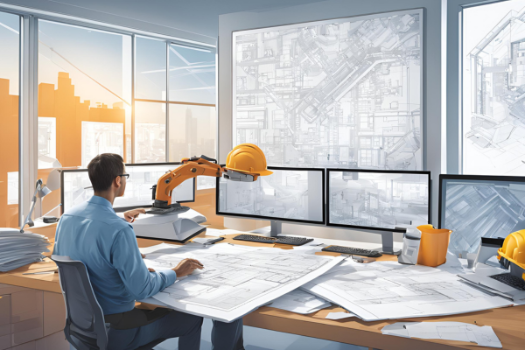.png)
BIM in Action: Simplifying Construction from Blueprint to Maintenance
Introduction: The Evolution of Construction Management
Construction projects have always faced big challenges. Miscommunication between teams leads to errors. Cost overruns happen when budgets aren’t managed well. Delays throw off project timelines and create stress for everyone involved.
Building Information Modeling (BIM) is changing this. It’s a digital solution that simplifies construction. BIM helps teams communicate better, plan smarter, and avoid costly mistakes. It’s transforming how projects are designed, built, and maintained.
This article will explore BIM in action. You’ll see how it improves each step of construction—from the first blueprint to ongoing building maintenance. By the end, you’ll understand why BIM is the future of construction management.
Understanding BIM: A Comprehensive Overview
Building Information Modeling (BIM) is a digital tool used in construction. It creates a detailed model of a building, showing both its physical structure and how it functions. This model becomes a shared resource for everyone involved, from design to maintenance.

BIM has three key components. The first is 3D modeling, which gives a clear, visual representation of the building's design. Next is data integration, which includes information about materials, systems, and how the building will perform. Finally, BIM acts as a collaborative platform, letting architects, engineers, and contractors work together in real time.
In today’s fast-moving construction world, BIM is a game-changer. It boosts efficiency, ensures accuracy, and improves teamwork. By bringing all stakeholders onto the same page, it simplifies complex projects and delivers better results.
BIM in the Design Phase: Enhancing Precision and Collaboration
Building Information Modeling (BIM) transforms the design phase of construction. With BIM, teams create detailed 3D visualizations of the project. These visual models help everyone involved see exactly what the finished building will look like. Stakeholders can walk through the design virtually, spotting areas that need improvement. This leads to better understanding and allows for refinements before construction begins.

One of the key benefits of BIM is clash detection. This feature identifies conflicts in the design, like plumbing running into electrical wiring. By finding these issues early, BIM prevents costly errors that would otherwise be discovered on-site. Fixing problems in the design phase saves time and money.
BIM also fosters a collaborative design environment. Architects, engineers, and clients can all work together within the same digital model. Changes made by one team member are instantly visible to others. This real-time collaboration ensures everyone is on the same page. Decisions are made with full information, reducing misunderstandings. The result is a design that meets the project's goals and satisfies all parties involved.
BIM During Construction: Streamlining Processes and Reducing Waste
During construction, BIM takes project management to the next level. With 4D BIM, time is added to the 3D model. This allows teams to create detailed construction schedules. Builders can see what needs to be done each day and in what order. Resources are allocated efficiently, and delays are easier to avoid. It helps keep the project on track from start to finish.

5D BIM brings cost management into the mix. By adding financial data to the model, teams can accurately estimate costs for materials, labor, and equipment. This reduces the risk of overspending. Real-time updates ensure budgets stay under control as the project progresses. Financial surprises become a thing of the past.
BIM also boosts on-site efficiency. Teams have instant access to real-time data through digital devices. This means construction crews always have the latest plans and updates. Miscommunication is reduced, and tasks are completed faster. BIM also helps track material usage, ensuring nothing is wasted. By minimizing errors and waste, BIM saves time and money while promoting sustainable practices.
From scheduling to budgeting to execution, BIM simplifies construction and ensures better results.
BIM in Facility Management: Extending Value Beyond Construction
BIM continues to deliver value long after construction is finished. It acts as a digital repository of detailed information about the building and its components. Every element, from HVAC systems to plumbing fixtures, is cataloged in the model. Facility managers can quickly access this data when performing maintenance or planning upgrades. This comprehensive asset information makes operations smoother and more efficient.

BIM also supports predictive maintenance. By analyzing the data stored in the model, managers can anticipate when equipment might need repairs or replacements. This prevents unexpected failures and reduces costly downtime. For example, if the model shows wear-and-tear trends for a heating system, maintenance can be scheduled before a breakdown occurs. Predictive maintenance helps extend the lifespan of building assets.
Energy management is another area where BIM shines. The model tracks energy use throughout the building, identifying areas of inefficiency. Facility managers can then make adjustments to optimize energy consumption. Whether it’s adjusting lighting schedules or upgrading insulation, BIM provides the insights needed to meet sustainability goals.
By integrating detailed information, predictive tools, and energy tracking, BIM ensures that buildings operate at their best for years to come.
Implementing BIM: Best Practices and Considerations
Successfully implementing BIM requires careful planning and commitment. It starts with strategic planning. Teams need a clear roadmap for how BIM will be used, ensuring it aligns with project goals. Setting clear objectives, like improving collaboration or reducing costs, helps guide the process and keeps everyone focused.

Training and skill development are equally critical. BIM tools are powerful, but teams must know how to use them effectively. Investing in training programs ensures that architects, engineers, and contractors have the skills they need. This builds confidence and improves the overall efficiency of the project.
Finally, continuous improvement is key. Projects evolve, and so should the use of BIM. Gathering feedback from team members helps identify areas for improvement. Regularly refining processes ensures BIM stays effective and adaptable for future projects.
By focusing on strategy, skills, and growth, teams can unlock the full potential of BIM.
Conclusion: The Future of Construction with BIM
BIM has revolutionized the construction industry. It simplifies complex processes, enhances collaboration, and adds value at every stage of a building’s lifecycle. From precise designs to efficient construction and ongoing maintenance, BIM ensures projects are delivered on time, within budget, and to a higher standard.
The construction industry is evolving, and BIM is leading the way. To stay competitive and meet modern demands, professionals must embrace this powerful tool. By adopting BIM, teams can work smarter, reduce waste, and deliver better results. The future of construction is here—make BIM part of your journey.